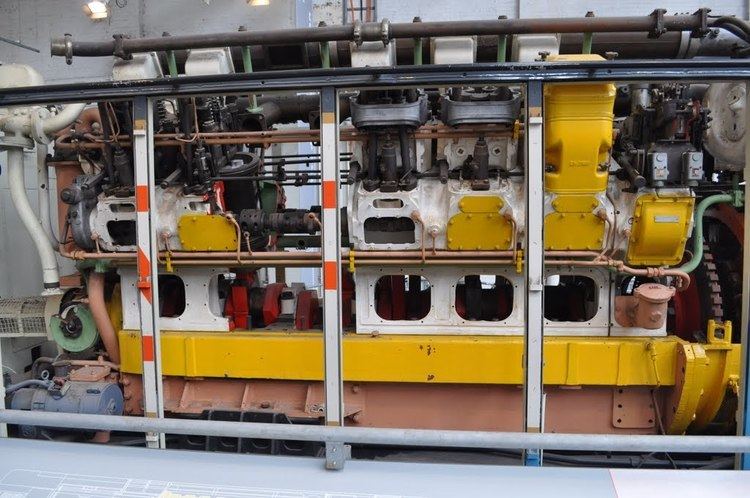English Electric diesel engines were manufactured by the English Electric company of the United Kingdom for both stationary and rail transport use. The range was derived from the "K type" engine (10" bore x 12" stroke), developed in the 1930s. These diesel engines were marketed under the English Electric name into the 1960s and, later, under the name Ruston-Paxman.
The "K" type engine had 2-valve cylinder heads and ran at 600-680 rpm. The Mark I "RK" and "V" types had 2-valve cylinder heads. The Mark II "RK" and "V" types had 4-valve cylinder heads. They ran at 750-900 rpm, and were available with turbochargers and intercoolers.
Number of cylinders:
K and RK types, 4, 6, 7 and 8 in line
V type, V8, V12 or V16
Cylinder bore: 10" (254mm)
Piston stroke: 12" (305mm)
Displacement: 942 cu. in (15.445 litres) per cylinder
Power range: 60-275 bhp per cylinder
Rotational speed: 630-900 rpm
Cooling: water
Designations (example, 12CSVT):
12 = number of cylinders
C = intercooler
S = turbocharger (supercharger)
V = V engine
T = traction, M was used for Marine use
A large number of these engines were built and these are just a few examples:
All cylinder numbers were used in Australia.
7SKM 500BHP @ 600RPM Manly Ferries: North Head and Baragoola (Four Engines) and Bellubera (Three Engines advertised as 600BHP @ 600RPM)
16CSVM Royal Aust Navy Oberon class submarine
Port Phillip Bay pilot ship DE (or MV or TS) Wyuna having three 8RKM and two 4RKM engines, originally having a third 4RKM but this was removed in 1980's and is with the Australian Maritime College.
4SRKT, (500 hp) SAR 500 class
6KT, (350 hp) VR F class
6RKT, (350 hp) SAR 350 class
6SRKT, (380 - 800 hp) SAR 800 class, WAGR F class, Tasmanian Government Railways Y class, Tasmanian Government Railways X class
6CSRKT, (840 - 930 hp) WAGR H class, Queensland Railways 1600 class & 1620 class, Aust Iron & Steel
8SRKT, (730 - 790 hp) Aust Iron & Steel
8SVT, (950 hp) WAGR G class
12SVT, (1200 - 1535 hp) Queensland Railways 1200 class, 1250 class & 1270 class
12CSVT, (1535 - 2550 hp) WAGR C class, K class & R class, Queensland Railways 1300 class, 2350 class & 2370 class, Tasmanian Government Railways Z class & Za class, Aust Iron & Steel
16SVT, (1588 hp) SAR 900 class
NSW was the only state not to have EE powered locos, Vic only had a few (F class).
6KT (600 hp) Malayan Railways Class 15
12SVT (1,500 hp) Malayan Railways Class 20
8CSVT (1,710 hp) Malayan Railways Class 22
Netherlands
6KT (400 bhp) NS Class 600
New Zealand
6SRKT Mk 1 (660 bhp) NZR DE class
12SVT Mk 2 (1500 bhp) NZR DF class (1954)
6SRKT Mk 2 (750 bhp) New Zealand DG and DH class locomotive
6CSRKT (1012 bhp) NZR DI class,
6CSRKM NZR rail ferries Aramoana, Aranui, Aratika, Arahunga
16CSVM NZR rail ferries Aramoana, Aranui
8CSVT (1330 bhp) CP Class 1400
16CSVT (2700 bhp) CP Class 1800
12CSVT (1800 bhp) Rhodesia Railways class DE3
16SVT (1750 bhp) Rhodesia Railways class DE2
6KT Litt V1 Nr 3 & 4 350 hp
4SRKT (500 bhp) British Rail Class 201, (550 bhp) UTA 70 Class (transferred to NIR Class 450), NIR Class 80 & 4SRKT MkII (600 bhp) British Rail Class 73, British Rail Class 202, British Rail Class 205, British Rail Class 207
6KT (350 bhp) British Rail Class 08, British Rail Class 09, British Rail Class 11, British Rail Class 12, British Rail Class 13
8SVT (1,000 bhp) British Rail Class 20
8CSV (1,050 bhp) Power Generation
12SVT (1,470 bhp) British Rail Class 31
12CSVT (1,750 bhp) British Rail Class 37
16SVT
1,600 bhp with Brown Boveri turbochargers, British Rail Class D16/1
1,750 bhp (one-hour rating) with Napier turbochargers, British Rail Class D16/2
2,000 bhp British Rail Class 40
16CSVT (2,700 bhp) British Rail Class 50
16RK3CT (3,250 bhp) British Rail Class 56 as Ruston-Paxman
12RK3ACT (3,300 bhp) British Rail Class 58 as Ruston-Paxman

